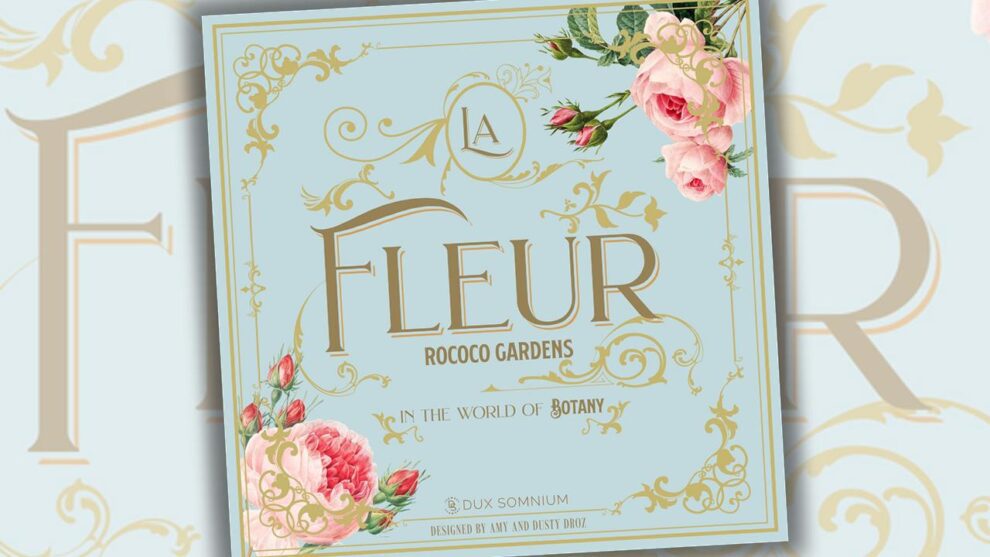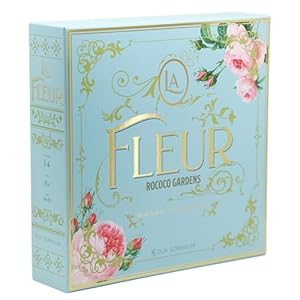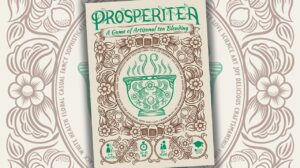A long, long time ago, while I was in junior high school and high school, my favorite modern game designer was Steve Jackson. Games like Vampire, Those Awful Green Things from Outer Space, and Illuminati were staples in my board gaming diet. There were other games that intrigued me in those days, for sure. But the designer of whom I knew the name and reputation would be Mr. Jackson. Flash forward a bit, after an attempt at college and a decade in the Navy, I would rediscover board gaming with a host of fresh faces. Over time, I cultivated other designs and other designers. Last year, if you asked me who my favorite game designer was, I would have listed names like Rudger Dorn, Antoine Bauza, Jamey Stegmaier, and Elizabeth Hargrave.
But with two games in my collection from Dux Somnium games (and another from their latest Kickstarter on the way), I am going to have to push Amy and Dusty Droz to the top of that list. I recently reviewed their first game, Botany; today I look at La Fleur.
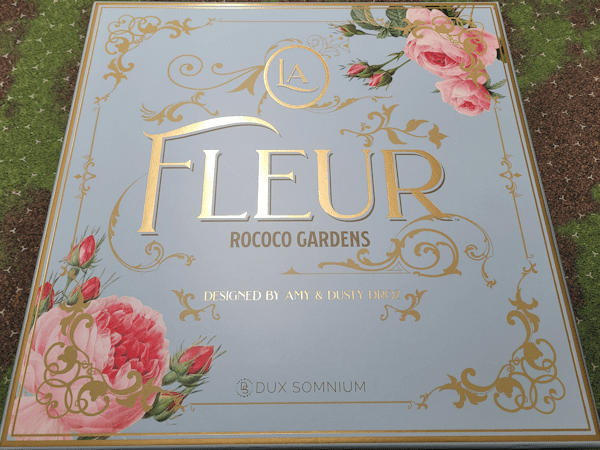
Garden Parties
In La Fleur, you are a socialite who wishes to rise in prestige by attracting the finest and most influential people to your estate during extravagant garden parties. To do this you need money to purchase flowers to construct garden features to attract the socialites who increase your prestige.
All of this is accomplished via a worker placement mechanism, where each worker is an artisan in your employ. When they go to a specific spot on the board, they have a special power to aid them—and you. You begin the game with two workers and can have as many as four. In addition to their utility as a worker running errands about the city, they also have a particular skill which can aid in constructing the garden features (e.g., making them less expensive).
Garden parties are happening quite often, so ensuring that your estate will attract the best and brightest is important. Falling behind in curating those relationships can be a sure path to defeat.

Livin’ La Vita Rococo
Setup
Setup is very straightforward. The main setup consists of:
- Place the game board (a beautiful cityscape) in reach of all players.
- Shuffle the five game decks (the artisan deck, the event deck, the flower deck, the garden feature deck, and the visitor deck) and place them on their designated spots on the board.
- Place the pawns and coins near the board and within reach of the players.
The player setup is no more taxing:
- Players take a chateau board and place it in front of them with room for their garden features. They also take the four pawns of their chosen color. They place the prestige token of their color on the main board near the prestige track.
- Each player takes five allure tokens (one of each color) and sets them near their chateau board. The tokens reflect the total strength of their gardens in the various categories that can attract visitors. These are: Architecture, Flowers, Paths, Vistas, and Water.
- The character cards are shuffled and two are dealt to each player. Players select one and return the other to the box. Each character has abilities that are triggered at the end of each round (see below).
- Deal three artisan cards to each player. Players select two and discard the remaining artisan. The chosen artisans are placed into the first two places of the chateau board, along with two pawns of the player’s color. The remaining two pawns are set aside for use when the player gains more artisans.
- Each player gets three coins to start.
- Each player is dealt three flower cards to start.
- Choose a random player and give them the first player token.
Setup is complete.
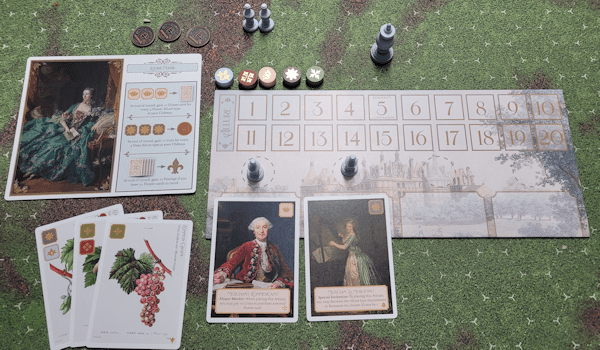
Game Turn
A game round consists of four phases:
Start of Round
At the start of the round, several cards are revealed.
- Any empty garden features spots are filled by drawing from the garden features deck.
- Any empty flower spots are filled by drawing from the flower deck.
- One visitor per player is drawn from the visitor deck and placed into the designated spots. If any players have 4+ prestige, add another visitor. If any players have 8+ prestige, add another visitor. If any players have 12+ prestige, add another visitor. All this means, if any players have 12+ prestige, the number of visitors will be equal to the number of players plus three.
- With the exception of the first turn of the game, draw an event card and follow its instructions.

Placing Artisans
Each player starts with two artisans (represented both by a pawn and a card that describes the artisan’s special ability and the area in which they have skill). Each pawn can be placed on the board in one of the action spaces:
- Flower Market–when an artisan is placed here, the player can acquire one flower card. They may select any face-up card in the market, or take their chances with the top card of the deck. Flowers have one or two allure types. Flowers with one specific allure type cost no coins. Flowers with a wild allure symbol (usable as any type) cost one coin. Flowers with two specific allure types cost two coins.
- Garden Features–when an artisan is placed here, the player may purchase one garden feature. Each feature has a cost measured in allure symbols present on flower cards in their hand. Each symbol on a spent card is used; any symbols on cards with two symbols that are not used are lost. Wild allure symbols can be used for any allure type. In addition to using flowers from their hand, a player may turn one of their artisan cards sideways to indicate they are using the artisan’s skill (at the top of the card) to pay part of the cost. Each artisan may be used this way once per round. After a feature is purchased, the player’s allure tokens are moved to reflect all of the allure the feature cost. For example, if a feature requires 3 Architecture and 2 Water to build, the player increases the level of allure for their chateau by +3 Architecture and +2 Water when they purchase it.
- Artisan Guild–when an artisan is placed here, the player may either hire a new artisan, or replace an existing artisan. A player with fewer than four artisans may go to this space, pay eight coins, and draw the top card from the artisan deck, adding this individual to their roster. As soon as the new artisan is acquired, their pawn is placed on the chateau board, making them available immediately. A player may, instead, go to this space and pay four coins to draw the top card from the artisan deck and replace an existing artisan in their roster.
- Special Invitation–when an artisan is placed here, the player may place the pawn on one of the face-up visitor cards. When the garden party takes place later in the turn, if players are tied in their allure for that visitor, the tied player who issued the special invitation wins and pulls that visitor to their garden party. This is also used for romancing a visitor (see below).
- Coin–when an artisan is placed here, the player gains two coins. A player may only place one artisan on this space per round.
- Prestige–when an artisan is placed here, the player gains one prestige. A player may only place one artisan on this space per round.
Starting with the player who has the first player token and going clockwise, players take turns placing one of their artisans. Each space can handle multiple players going there, and all but two (e.g., Coin and Prestige) can handle multiple artisans from the same player.
Once a player runs out of artisans, they pass and the remaining players continue placing their artisans one at a time. Once all artisans have been placed, this phase ends.
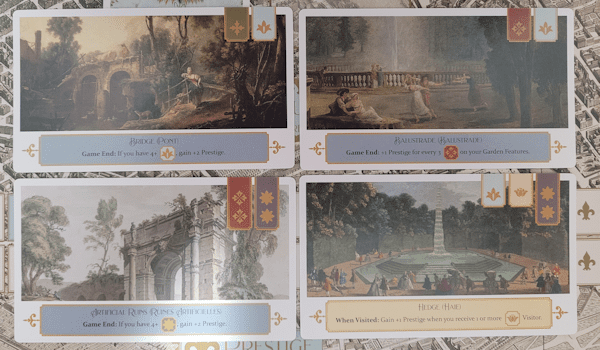
Garden Party
Each visitor has an element of gardens they prefer. The player who has the most allure in that element (e.g., Architecture, Flowers, Paths, Vistas, or Water) will attract that visitor to their garden party. If there is a tie, the visitor is unable to decide which party to go to and will visit nobody (unless they received a special invitation from one of the tied players).
Once all visitors have been checked for which garden party they will attend, and all have been resolved, they all return to their homes (e.g., are discarded to the board).
Garden Feature and Visitor Abilities
Garden Features and visitors have special abilities.
Visitors have special abilities which are triggered as soon as they arrive at a garden party.
Garden Features have abilities that can be “when acquired” (triggered when the feature is purchased), “round end” (triggered during the cleanup step at the end of the round), “game end” (triggered during the scoring phase at the end of the game), or “when visited” (triggered when one or more visitors comes to a garden party and has the appropriate element as their preferred).
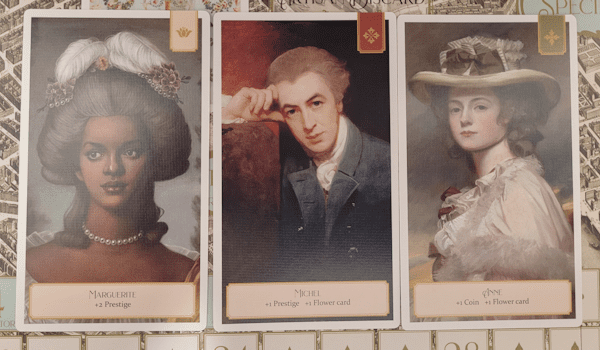
Romance
A visitor who was issued a special invitation, and arrives at that player’s garden party, where that garden party features 5+ allure in the visitor’s preferred element, may be romanced by the player to become their companion. If the player elects to do this, the visitor does all it normally does. However, after the garden party is over, the visitor remains at the chateau (e.g., they are placed next to the character card). This visitor will automatically show up to all of that player’s future garden parties – they are treated as a visitor in all ways, but never leave. A player may only have one companion; they cannot be replaced.
End of Round
This is a cleanup phase with a few extra (important!) steps.
- Garden Features with “end of round” abilities are all triggered.
- Character abilities are triggered.
- Artisans that were rotated to use their skill to build a feature are reset.
- Artisan pawns are returned to their spots on the chateau boards.
- All visitors (but not companions) are discarded.
- The first player pawn is passed to the next player clockwise.
- Check for the end of game trigger.
The “end of game” is triggered when any player ends a round with 12+ prestige. If nobody has enough prestige, the game returns to the Start of Round step and the next round begins.
If the “end of game” is triggered, play still returns to the Start of Round step, but this is the Grand Soiree – the final round of the game. At the end of this final round, all “end of game” garden features are also scored. Additionally, players get prestige points for:
- Coins–each player gets one prestige point for every eight coins they have.
- Flower Cards–each player gets one prestige point for every three flower cards they have in hand.
The player with the most prestige is declared the host of the Grand Soiree, and is the winner. In case of a tie, the tied player with the most total allure in the garden is the winner. If there is a tie, the players share the victory.
Expansions
La Fleur has two expansions (so far).
- Rose Rococo–adds Roses and a special market (e.g., a new space for artisans to visit) in order to acquire these special flowers. Additionally, there are new artisans, visitors, and features that take advantage of them.
- L’Orient–adds exotic Eastern flowers and a special market (e.g., a new space for artisans to visit) in order to acquire these special flowers. The flowers are not used to gain garden features, instead they are placed into exquisite vases and are used from there. To accommodate this, there is a special trade space (e.g., another new space for artisans which utilizes a special die) to get the vases. Additionally, there are new artisans, visitors, garden features, and events that all reference these flowers.
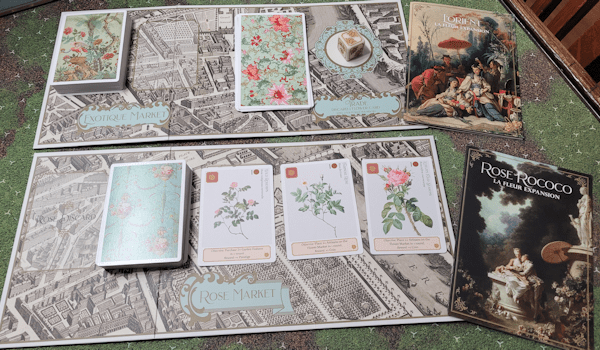
Final Thoughts
I love this game. It is a wonderful engine: getting the coins to get the flowers to get the garden features to get the visitors to get the prestige. It all works so very well and is a lot of fun. After just a few plays, I saw that multiple strategies work. In one game, for example, I had four artisans and my wife had just her initial two. She used them very efficiently, and our scores were within one point of each other!
Although this is a beautiful game and definitely deserves the 5-star rating I am giving it, it is ever so slightly less than Dux Somnium’s previous work. The reasons are just as deep into the minutia as my complaints against Botany. For example:
- Money is just as important here as it is in Botany, but comes into the scoring calculations at the end. Given that money (like in Botany) is a means to an end, not an end unto itself, I really wish this has not been the case.
- Prestige is just as important as Reputation is in Botany, but here it becomes the entire focus of the game since it is both the end-game trigger and the final score. I really wish they had separated the final score from the Prestige as they did in Botany. Having this be the combination of the two leaves one with a nagging feeling a bit of depth was lost.
Again, exceedingly minor. This is an excellent game and one I look forward to each time we pull it off the shelf.
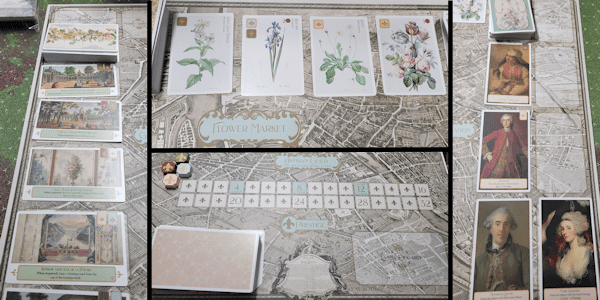
Afterthought
As I discover the imagination of Amy and Dusty Droz, I am reminded of Elizabeth Hargrave. I love Elizabeth Hargrave’s games not only for the fact that they are excellent games, but because of the drive behind each game.
- She looked at a gaming market flooded with war games and the like and asked, “Is there a peaceful game about birds?” When the answer was no, she created Wingspan.
- She asked, “Is there a peaceful game about butterflies and their amazing migration?” When the answer was no, she created Mariposas.
- She asked, “Is there a peaceful game about the incredible relationship between trees and mushrooms?” When the answer was no, she created Undergrove. And so on…
She creates games about the things she loves and effectively shares that love with an eager audience!
I feel the same drive in Amy and Dusty Droz. They obviously love flowers, very particular periods in history, a certain romantic elegance, and so on. It shows. They also love games that feel as luxurious as the times within which they are set. This member of their audience remains as eager as ever.


